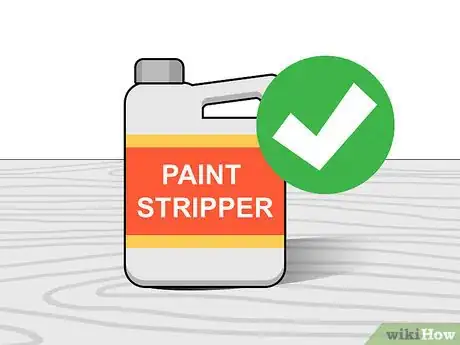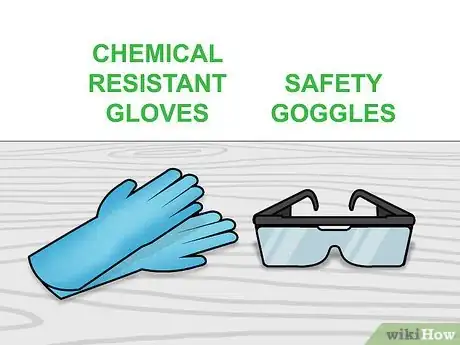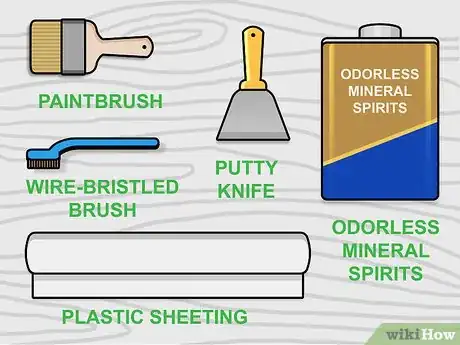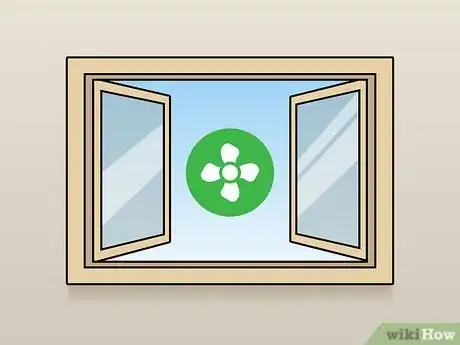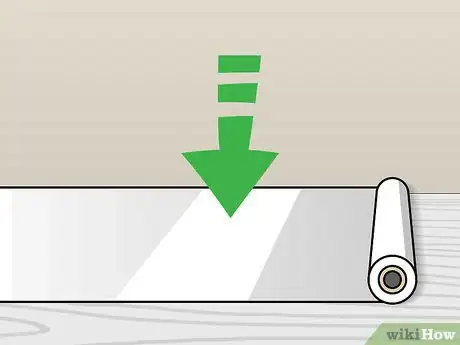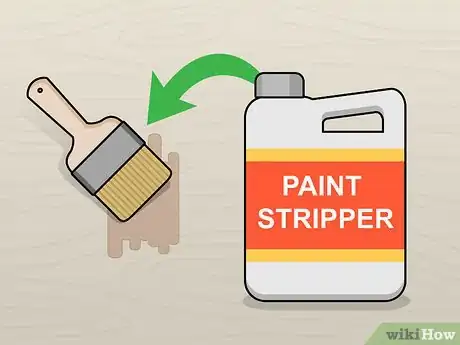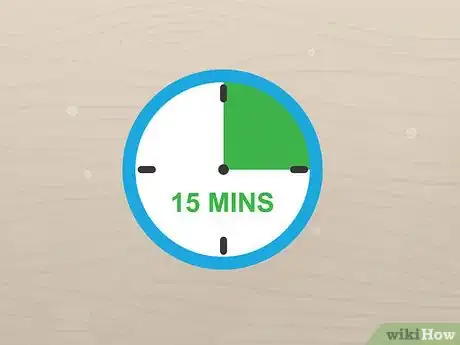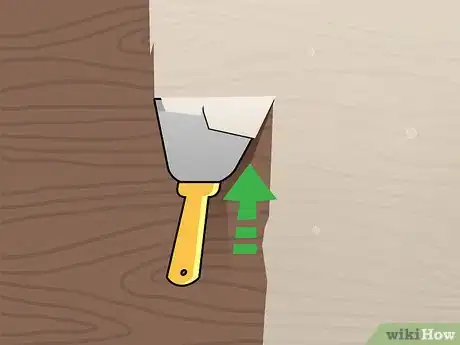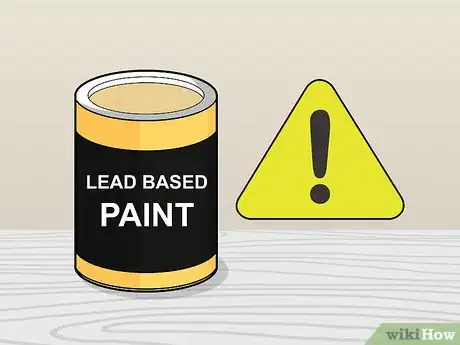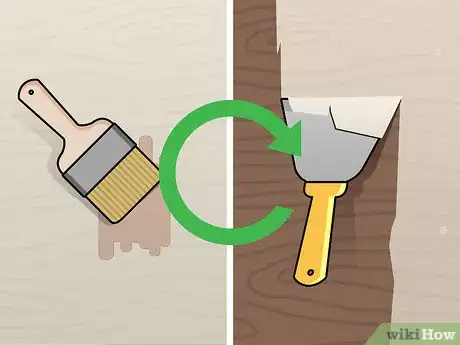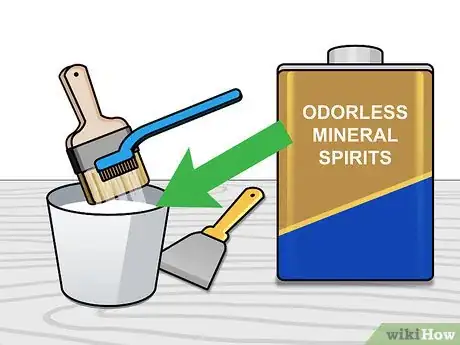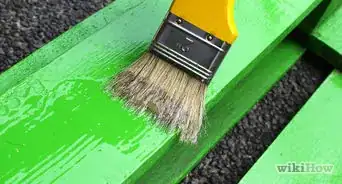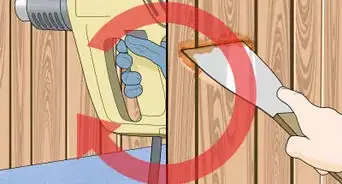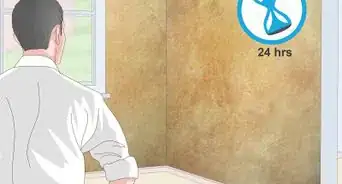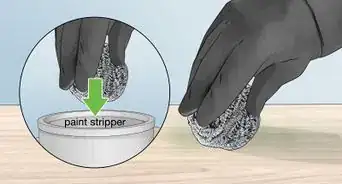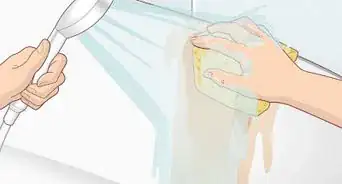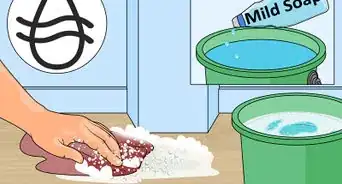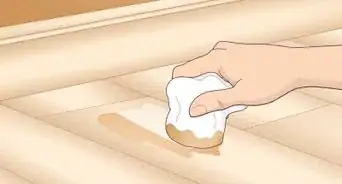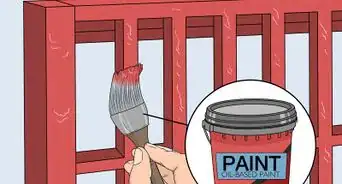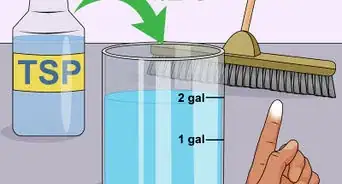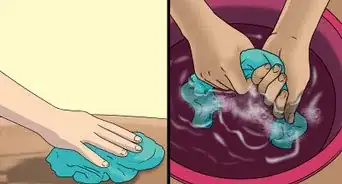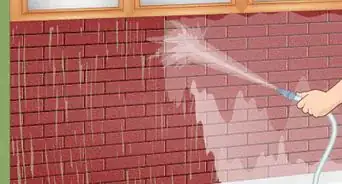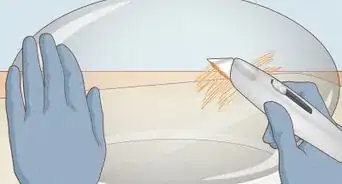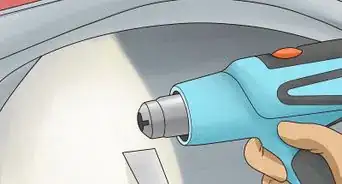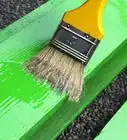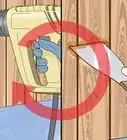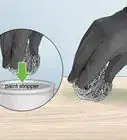This article was co-authored by Patrick Coye. Patrick Coye is the owner and operator of Patrick’s Painting & Home Improvement in Alexandria, Virginia. With over 15 years of experience in residential construction, Patrick specializes in painting, wallpaper removal/installation, drywall, staining decks and fences, and kitchen cabinetry painting. To date, Patrick and his team have painted over 2,000 houses and stained over 800 decks. Patrick's Company won a "Top Job" award from the American Painting contractor magazine in 2020.
This article has been viewed 107,455 times.
If you have a wooden surface that has been painted with a latex-based paint, you can remove the paint relatively easily. To avoid any risk of harm to your health, use a nontoxic chemical paint stripper. You’ll also need to visit a hardware store to purchase other paint-removal supplies. This method of removal will not damage the wood itself, so you’ll be able to re-paint or varnish the surface once you’ve removed the latex paint.
Steps
Collecting Necessary Supplies
-
1Purchase a chemical paint stripper.[1] Paint strippers are gel-like products that will adhere to and dissolve latex paint, allowing you to scrape it off of a wooden surface. Look for a paint stripper at your local hardware store or home and garden supply store. Popular and non-toxic brands include CitriStrip, Safest Stripper, and SoyGreen.[2]
- Modern paint strippers offer several advantages over the older style of chemical stripper. Older paint strippers were noxious and needed to be used outdoors.
- Newer, safer chemical paint strippers can be used indoors and do not contain methylene chloride.
-
2Use safety goggles and chemical resistant gloves.[3] Even a non-toxic chemical paint stripper can be harmful if it gets in your eyes or has prolonged contact with your skin. To protect yourself, purchase a pair of safety goggles and a pair of protective gloves.[4] Both gloves and goggles should be available at your local hardware store.
- Don’t buy regular latex gloves, since you’ll be working with a product designed to dissolve latex. Ask the hardware store sales clerk to recommend a pair of gloves that are resistant to chemical paint strippers.
Advertisement -
3Purchase tools to apply stripper and remove paint. Visit your local hardware store and buy a sturdy paintbrush, a wire-bristled brush, a putty knife, plastic sheeting, and odorless mineral spirits.[5]
- Instead of the wire-bristled brush, you could purchase steel wool pads.
Applying the Paint Remover
-
1Ventilate the room you’re working in. Even relatively safe chemical paint strippers are unhealthy to inhale. Make sure you’re working in a well-ventilated environment by opening an external door or window.[6]
- If you have an electric fan, set it up to blow air from the room you’re working in out of an open window.
-
2Lay down plastic sheeting. If you’re removing paint from an interior wall, put down plastic to protect the flooring from the chemical paint stripper. Any paint stripper that falls onto flooring—especially carpet or hardwood—could permanently discolor the material.
- Alternately, if you are removing paint from a small piece of furniture (e.g. a chair) that can be carried outside, you will not need to put down plastic sheeting.
- Likewise, if you’re removing latex paint from an interior door, take the door off of its hinges and work outside.
- Biochemical strippers will not damage grass or discolor concrete. However, more aggressive caustic strippers or solvent-based strippers can damage your lawn and other organic materials.[7]
-
3Brush the chemical paint stripper onto the latex paint. The paint stripper will have a gel-like consistency. Use your paintbrush to apply a generous layer of stripper to the paint. Apply the stripper in long, smooth strokes to ensure that it’s applied evenly across the wooden surface.[8]
-
4Wait 15 minutes. This will give the paint stripper time to soak into the latex paint and begin to weaken the paint’s attachment to the wood. As the stripper sits, you’ll begin to notice small bubbles forming. This is a sign that the paint is ready to be stripped off.[9]
- If the paint stripper hasn’t started to bubble after 15 minutes, wait another 5 minutes.
Stripping the Paint
-
1Scrape the paint off with the putty knife.[10] Angle the putty knife away from yourself so that you can push against the painted surface and scrape all of the layers of latex paint off of the underlying wood.[11] As you scrape, be careful not to damage the wood itself. You’ll probably give the wood some minor scratches, but that’s not a problem.
- Dispose of the scraped-off latex paint and stripper in a sealable plastic bag.
-
2Take dramatic safety precautions if you’re removing lead paint. Paint that was applied prior to 1978 probably contains lead, and exposure to chips or dust from lead paint can lead to serious health concerns. If you suspect that you’re dealing with an older, lead-based paint, wear clothing, shoes, and a hair net that you can throw away after paint stripping. Also wear eye goggles and a HEPA air respirator.[12]
- Prior to stripping any lead-based paint from a room, remove every possible item, including furniture, books, electronic equipment, children’s toys, bedding, drapery, and rugs.
- No animals, children, or pregnant women should be in the room in which you’re removing a lead-based paint.
-
3Re-apply stripper and scrape as needed. Depending on how many layers of paint have been applied to the wooden surface, you may need to repeat this process several times. Each time, paint on more stripper, wait at least 15 minutes, and scrape off as much of the paint as possible.[13]
-
4Dip your wire brush in odorless mineral spirits and remove the last of the paint. Mineral spirits will remove any lingering paint that you haven’t been able to scrape off with the putty knife. If you purchased steel wool instead of a wire brush, it will work well for this task also.[14]
- Once the paint is all removed, clean off the wood with a damp rag. Allow the wood to dry.
-
5Wash the paint brush and putty knife with odorless mineral spirits. The spirits will strip off any chemical stripper or paint that has stuck on the brush and knife. Use a firm wire brush or steel wool to fully clean off all of your tools.[15]
- Dispose of dirty rags and plastic by sealing them in a plastic bag and throwing them in the trash.
Expert Q&A
-
QuestionHow do you remove latex paint from wood?
 Patrick CoyePatrick Coye is the owner and operator of Patrick’s Painting & Home Improvement in Alexandria, Virginia. With over 15 years of experience in residential construction, Patrick specializes in painting, wallpaper removal/installation, drywall, staining decks and fences, and kitchen cabinetry painting. To date, Patrick and his team have painted over 2,000 houses and stained over 800 decks. Patrick's Company won a "Top Job" award from the American Painting contractor magazine in 2020.
Patrick CoyePatrick Coye is the owner and operator of Patrick’s Painting & Home Improvement in Alexandria, Virginia. With over 15 years of experience in residential construction, Patrick specializes in painting, wallpaper removal/installation, drywall, staining decks and fences, and kitchen cabinetry painting. To date, Patrick and his team have painted over 2,000 houses and stained over 800 decks. Patrick's Company won a "Top Job" award from the American Painting contractor magazine in 2020.
Painting Specialist There are two methods you can use. You can strip it by sanding it, which is fairly labor intensive. Start with a low-grit sandpaper and work your way up towards a high-grit sandpaper. Alternatively, you can use a gel or liquid stripper. Roll it onto the surface with a roller or brush it on with a paintbrush, then wrap it in plastic. The next day, put on some latex gloves and a long-sleeve shirt, then unwrap the plastic and remove the excess paint with a putty knife and rags.
There are two methods you can use. You can strip it by sanding it, which is fairly labor intensive. Start with a low-grit sandpaper and work your way up towards a high-grit sandpaper. Alternatively, you can use a gel or liquid stripper. Roll it onto the surface with a roller or brush it on with a paintbrush, then wrap it in plastic. The next day, put on some latex gloves and a long-sleeve shirt, then unwrap the plastic and remove the excess paint with a putty knife and rags. -
QuestionI have a room that has vertical cedar planks (very rough-cut cedar) that were painted over with a latex paint sometime in the last century. I want to strip the latex off and use a stain. How do I do this, and with what?
 Community AnswerIt isn't possible to "remove" latex paint that has soaked into raw wood. That's especially true if you want the wood to remain raw when you're finished taking off the paint. The only way I have ever found to do this is to sand off the top layer of wood. If your planks have grooves, as in ordinary tongue-in-groove planks, it will be very difficult to get the latex paint out. Latex is, of course, water-based, and water seeps into wood, carrying the pigment with it. There are some very specific solvents for latex paint, but they are costly, extremely toxic, and require dipping and soaking. Specialist needed.
Community AnswerIt isn't possible to "remove" latex paint that has soaked into raw wood. That's especially true if you want the wood to remain raw when you're finished taking off the paint. The only way I have ever found to do this is to sand off the top layer of wood. If your planks have grooves, as in ordinary tongue-in-groove planks, it will be very difficult to get the latex paint out. Latex is, of course, water-based, and water seeps into wood, carrying the pigment with it. There are some very specific solvents for latex paint, but they are costly, extremely toxic, and require dipping and soaking. Specialist needed.
Things You’ll Need
- Paint stripper
- Safety glasses
- Safety gloves
- Paint scraper tool
- Paint stripper scrubber
- Paint brush
- Odorless mineral spirits
- Plastic sheeting
References
- ↑ Patrick Coye. Painting Specialist. Expert Interview. 19 August 2020.
- ↑ https://www.thisoldhouse.com/ideas/safer-paint-strippers
- ↑ Patrick Coye. Painting Specialist. Expert Interview. 19 August 2020.
- ↑ http://www.prettyhandygirl.com/strip-paint-off-door/
- ↑ http://www.prettyhandygirl.com/strip-paint-off-door/
- ↑ http://www.prettyhandygirl.com/strip-paint-off-door/
- ↑ https://www.concretenetwork.com/remove-concrete-sealer/types.html
- ↑ http://www.prettyhandygirl.com/strip-paint-off-door/
- ↑ http://www.prettyhandygirl.com/strip-paint-off-door/
- ↑ Patrick Coye. Painting Specialist. Expert Interview. 19 August 2020.
- ↑ http://www.prettyhandygirl.com/strip-paint-off-door/
- ↑ https://www.health.ny.gov/publications/2502/
- ↑ http://www.prettyhandygirl.com/strip-paint-off-door/
- ↑ http://www.prettyhandygirl.com/strip-paint-off-door/
- ↑ http://www.prettyhandygirl.com/strip-paint-off-door/
